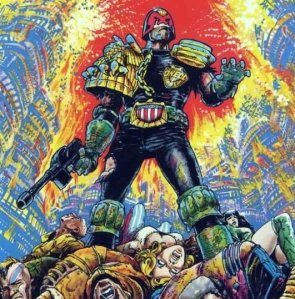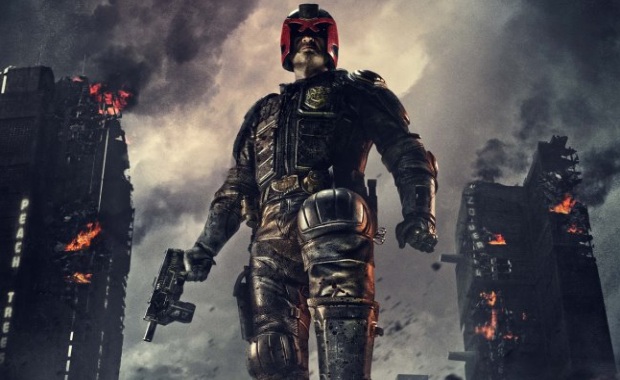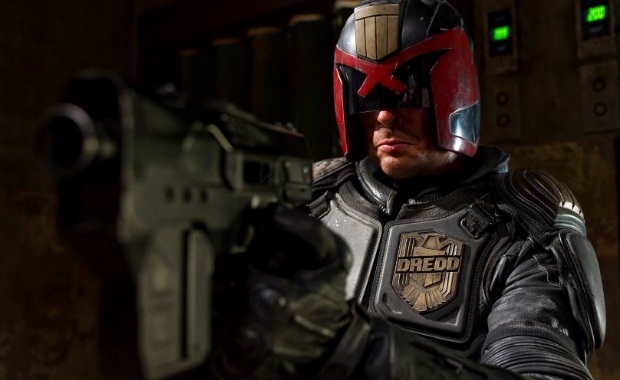Why “Dredd” Needs To Be Seen: A Spoiler-Free Review of Why Dredd Rocks
(Note: this review is based off of a 2D showing)
Unless you’re a fan of British comics and pop culture, chances are you won’t be familiar with 2000 AD’s comic hero Judge Dredd unless you’ve seen the 1995 Judge Dredd movie starring Sylverster Stallone. 2012’s Dredd starring Karl Urban and directed by Pete Travis is NOT that movie. And that’s good. Travis, Urban, and screenwriter Alex Garland take the character back to his roots and deliver a supreme Judge Dredd movie that properly introduces the iconic character to an American audience and offers a damn good movie while it does.
______________________________________________
The Premise
From IMDB (and written by the Dredd Production staff):
“The future America is an irradiated waste land. On its East Coast, running from Boston to Washington DC, lies Mega City One – a vast, violent metropolis where criminals rule the chaotic streets. The only force of order lies with the urban cops called “Judges” who possess the combined powers of judge, jury and instant executioner. Known and feared throughout the city, Dredd is the ultimate Judge, challenged with ridding the city of its latest scourge – a dangerous drug epidemic that has users of “Slo-Mo” experiencing reality at a fraction of its normal speed. During a routine day on the job, Dredd is assigned to train and evaluate Cassandra Anderson, a rookie with powerful psychic abilities thanks to a genetic mutation. A heinous crime calls them to a neighborhood where fellow Judges rarely dare to venture – a 200 storey vertical slum controlled by prostitute turned drug lord Ma-Ma and her ruthless clan. When they capture one of the clan’s inner circle, Ma-Ma overtakes the compound’s control center and wages a dirty, vicious war against the Judges that proves she will stop at nothing to protect her empire. With the body count climbing and no way out, Dredd and Anderson must confront the odds and engage in the relentless battle for their survival.”
Dredd’s premise is perfect. It sets up an incredible scope for the movie, and, for the most part, it succeeds. From the ground floor of the Peach Trees Mega Block, to the top, Dredd offers a thrilling suicide run fraught with danger, humor, some character development, and of course, some pretty intense graphic violence. Thankfully Dredd doesn’t overdo it for the sake of some petty grindhouse horror-fest (though there are quite a few scenes that will make you cringe). Instead, Dredd offers a pretty good–if straight-forward–story, one that definitely revolves around the titular character, but arguably centers on Anderson. The two together provide the heart and soul of the movie, making each inescapable situation and each violent confrontation nuanced and driven. You won’t find anything Oscar-Worthy in Dredd, but it delivers a compelling plot and some really fierce situations that really make Dredd work.
______________________________________________
The Characters
The use of Anderson (Olivia Thirlby) as the audience’s gateway to this world is used well: she’s a rookie. Not completely helpless, but unaccustomed to the horrors Judges face day to day. Anderson’s main role is as a contrast to Dredd himself, the yin to his yang, providing a link to the humanity Dredd is unable to show himself. He is grim, he is a mystery, and you will never see more than his scowling lips and steely jaw for the entire film.
 This is not a flaw of the script, or of Urban, but an ode to Dredd’s character that director Travis and screenwriter Garland had to work with to keep the character true. See, John Wagner and Carlos Ezquerra–the creators of the character– have often said that the character’s face should never be shown. 1995’s Judge Dredd biggest flaw–according to many fans–was ignoring one of the character’s core design elements. Dredd represents the Law (hence his most-known catchphrase “I am the Law!”) and he represents it’s faceless quality. The Law isn’t a person or a feeling, it’s a symbol, especially in this horrible dystopian wasteland, a symbol of much needed order. Like Christopher Nolan’s Batman in crime-laden Gotham, he represents a symbol, a system he believes in, to his core. Despite this (and how the trailers may seem), Dredd’s Dredd isn’t a one-note character, and the filmmakers–along with Urban–do well in making Dredd more than a caricature of the grim, gritty hero.
This is not a flaw of the script, or of Urban, but an ode to Dredd’s character that director Travis and screenwriter Garland had to work with to keep the character true. See, John Wagner and Carlos Ezquerra–the creators of the character– have often said that the character’s face should never be shown. 1995’s Judge Dredd biggest flaw–according to many fans–was ignoring one of the character’s core design elements. Dredd represents the Law (hence his most-known catchphrase “I am the Law!”) and he represents it’s faceless quality. The Law isn’t a person or a feeling, it’s a symbol, especially in this horrible dystopian wasteland, a symbol of much needed order. Like Christopher Nolan’s Batman in crime-laden Gotham, he represents a symbol, a system he believes in, to his core. Despite this (and how the trailers may seem), Dredd’s Dredd isn’t a one-note character, and the filmmakers–along with Urban–do well in making Dredd more than a caricature of the grim, gritty hero.
Going into this movie, I expected Dredd to just be this unstoppable instrument of death and destruction. A focused force of nature who stops at nothing to get the job done. And to an extent I was right. After all, the character is slightly influenced by Clint Eastwood’s character in Rawhide, the tough, grizzled hero archtype who keeps on coming until justice is served. But there are some nice moments where Dredd’s humanity slips through the cracks, where we can see beyond the visor without ever having to see his face. Where we see he is just a man, but a man who believes in a code.
Unlike some trigger happy hero of 90’s action cinema, he still follows the rules, even when dragging a suspect with him through dozens of floors could be a liability. When faced with critical situations he still tries to pull the potential out of Anderson, to get into her mind, to see if she she’s capable of being the Judge she thinks she can be. And the ally he needs to survive. And when faced with danger, he does get hurt. Sometimes badly.
But even beyond the violence, it’s his personality that really makes the movie shine. The one thing that keeps him going, even when knee-deep in the worst the world has to offer, even when he sees how flawed his own system is, is trying to maintain order. As he puts it, thousands and thousands of crimes happen every day. And the Judges can only respond to 6% of that total number. But at least someone’s trying. No matter how hard the work, someone has to do it, no matter how dangerous. And when the moment arises, he does crack the occasional one-liner that brings out the humor of an entirely desperate and tense situation.
The biggest flaw in Dredd is in the film’s villain, Ma-Ma (Lena Headey). Though not any fault of Headey, Ma-Ma is written as your garden variety bad gal, the typical unrelenting despot willing to sacrifice the lives of anyone to get what she wants. But even in her we see a contrast to Dredd: she does have her own order, her own system, her own answer to the problems of this new world. Arguably, before Ma-Ma arrived was disorder, with three rival gangs vying for territory in Peace Trees. So in her we see a parallel to Dredd’s Law: order through violence. But her order is based on corruption, vulnerability, and fear; Dredd’s order is through hope and will. Hope that things will–bit by bit–get better. That even those as powerful and frightening as Ma-Ma can be stopped. That order can be restored correctly, eventually.
That people like Dredd will be there even when the world ends and turns to shit.
______________________________________________
The Verdict
Dredd isn’t perfect. And neither is it for everyone: undoubtedly the M-rated violence may scare some viewers away, and the plot is decidedly simple and straight-forward. But it works. And it stays true to the character.
With some great action, good character development, a grim atmosphere, and good humor, Dredd is worth the price of admission. Go check it out.
I give Dredd
4 Scowls
Out of 5
______________________________________________
Judge Dredd Sites To Check Out
- 2000 AD. Site
- Perfect Jumping On Point To Start Reading Judge Dredd
- 35 Years of 2000 AD and Dredd
- IMDB’s Dredd Trivia Page
Related articles
- MOVIE REVUE: Don’t Judge This Movie by its Dredd-ful Past (therogersrevue.wordpress.com)
- Dredd 3D Review: The Judge is back, better than ever (digitaltrends.com)
- Judgement is Here (derekas.blogspot.com)
- Dread Dredd. Judge Dredd (symatt.wordpress.com)
- Movie Review: ‘Dredd 3D’ (Spoiler Free) (ifanboy.com)


